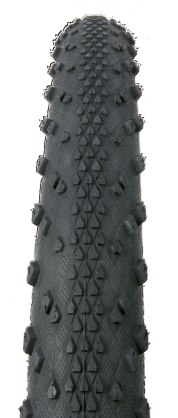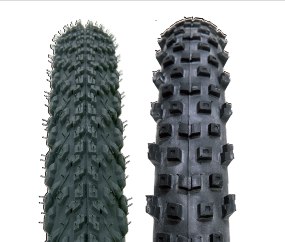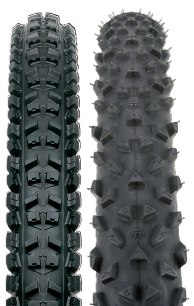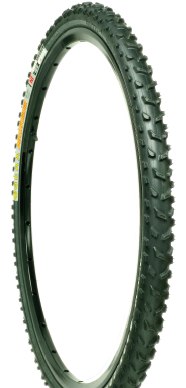Freedom of Choice
Tyres have a huge bearing on how your bike performs, but how do you select the right one for your needs ? So, rather than make specific recommendations about particular tyre models, we decided to produce this primer on tyre selection principles.
It’s inevitable that every mountain biker has to make the big decision; ‘what tyres will I put on my bike next?’ It is a big decision not because it is particularly difficult, rather because there is an almost overwhelming variety of tyres to choose from. Even those of you who have a favourite tyre will face this decision when production of that model stops. Road, track and touring cyclists just don’t understand the dilemma that faces off-roaders when it comes time to replacing their rubber.
Width
Most companies make each model of mountain bike tyre in at least two widths. Check out the catalogues and you’ll find that in some models there are five, or even more, widths to choose from. The Kenda Nevegal is an example of a tyre  that is offered in 1.95 inch and 2.7 inch and three sizes in between. This is as true for slick commuting tyres as it is for competition knobbies. All other things being equal (and they seldom are, but it makes sense to isolate each trait from everything else) the narrower the tyre, the less it weighs and the higher the pressure any given rider will have to run to keep the rim away from the trail. A 50kg elite racer who is ‘light’ on their bike and technically very competent might choose to compete on a 1.9 inch tyre. For a 100kg weekend warrior that doesn’t cope with sliding tyres very well and relies on the full suspension bike to get them over rough sections a 2.4 inch version of the same tyre might still be too narrow. More air pressure does reduce rolling resistance on hard surfaces but it also reduces grip, flotation and comfort. In rough terrain a larger volume/lower pressure option may be more efficient as you’ll get more power to the trail rather than pinging and bouncing off obstacles. Greater width also equals greater comfort which can lessen fatigue during longer rides or events. Narrower tyres have less air volume inside them, so whether you run tubeless or tubes you will ding the rims if you don’t run enough air pressure. The appropriate width is therefore trail, rider and bike dependent. As an extreme example, an all-mountain bike ridden on rocky trails requires much broader tyres than a svelte hardtail ridden across smooth hardpack. Tyre width can also affect how a tyre performs in muddy conditions. Wet clayey soils will cling to your tyres like glue. Wide tyres present more area to collect mud and less space around the tyre. As a result they can collect a hefty coating of mud that clogs the frame and halts forward motion—not much fun. As a result, narrow tyres may have merit if you have to ride on sticky muddy trails. Their ‘pizza cutter’ profile can also help them penetrate through the soft surface with the aim of finding traction in the harder soil below.
that is offered in 1.95 inch and 2.7 inch and three sizes in between. This is as true for slick commuting tyres as it is for competition knobbies. All other things being equal (and they seldom are, but it makes sense to isolate each trait from everything else) the narrower the tyre, the less it weighs and the higher the pressure any given rider will have to run to keep the rim away from the trail. A 50kg elite racer who is ‘light’ on their bike and technically very competent might choose to compete on a 1.9 inch tyre. For a 100kg weekend warrior that doesn’t cope with sliding tyres very well and relies on the full suspension bike to get them over rough sections a 2.4 inch version of the same tyre might still be too narrow. More air pressure does reduce rolling resistance on hard surfaces but it also reduces grip, flotation and comfort. In rough terrain a larger volume/lower pressure option may be more efficient as you’ll get more power to the trail rather than pinging and bouncing off obstacles. Greater width also equals greater comfort which can lessen fatigue during longer rides or events. Narrower tyres have less air volume inside them, so whether you run tubeless or tubes you will ding the rims if you don’t run enough air pressure. The appropriate width is therefore trail, rider and bike dependent. As an extreme example, an all-mountain bike ridden on rocky trails requires much broader tyres than a svelte hardtail ridden across smooth hardpack. Tyre width can also affect how a tyre performs in muddy conditions. Wet clayey soils will cling to your tyres like glue. Wide tyres present more area to collect mud and less space around the tyre. As a result they can collect a hefty coating of mud that clogs the frame and halts forward motion—not much fun. As a result, narrow tyres may have merit if you have to ride on sticky muddy trails. Their ‘pizza cutter’ profile can also help them penetrate through the soft surface with the aim of finding traction in the harder soil below.
 that is offered in 1.95 inch and 2.7 inch and three sizes in between. This is as true for slick commuting tyres as it is for competition knobbies. All other things being equal (and they seldom are, but it makes sense to isolate each trait from everything else) the narrower the tyre, the less it weighs and the higher the pressure any given rider will have to run to keep the rim away from the trail. A 50kg elite racer who is ‘light’ on their bike and technically very competent might choose to compete on a 1.9 inch tyre. For a 100kg weekend warrior that doesn’t cope with sliding tyres very well and relies on the full suspension bike to get them over rough sections a 2.4 inch version of the same tyre might still be too narrow. More air pressure does reduce rolling resistance on hard surfaces but it also reduces grip, flotation and comfort. In rough terrain a larger volume/lower pressure option may be more efficient as you’ll get more power to the trail rather than pinging and bouncing off obstacles. Greater width also equals greater comfort which can lessen fatigue during longer rides or events. Narrower tyres have less air volume inside them, so whether you run tubeless or tubes you will ding the rims if you don’t run enough air pressure. The appropriate width is therefore trail, rider and bike dependent. As an extreme example, an all-mountain bike ridden on rocky trails requires much broader tyres than a svelte hardtail ridden across smooth hardpack. Tyre width can also affect how a tyre performs in muddy conditions. Wet clayey soils will cling to your tyres like glue. Wide tyres present more area to collect mud and less space around the tyre. As a result they can collect a hefty coating of mud that clogs the frame and halts forward motion—not much fun. As a result, narrow tyres may have merit if you have to ride on sticky muddy trails. Their ‘pizza cutter’ profile can also help them penetrate through the soft surface with the aim of finding traction in the harder soil below.
that is offered in 1.95 inch and 2.7 inch and three sizes in between. This is as true for slick commuting tyres as it is for competition knobbies. All other things being equal (and they seldom are, but it makes sense to isolate each trait from everything else) the narrower the tyre, the less it weighs and the higher the pressure any given rider will have to run to keep the rim away from the trail. A 50kg elite racer who is ‘light’ on their bike and technically very competent might choose to compete on a 1.9 inch tyre. For a 100kg weekend warrior that doesn’t cope with sliding tyres very well and relies on the full suspension bike to get them over rough sections a 2.4 inch version of the same tyre might still be too narrow. More air pressure does reduce rolling resistance on hard surfaces but it also reduces grip, flotation and comfort. In rough terrain a larger volume/lower pressure option may be more efficient as you’ll get more power to the trail rather than pinging and bouncing off obstacles. Greater width also equals greater comfort which can lessen fatigue during longer rides or events. Narrower tyres have less air volume inside them, so whether you run tubeless or tubes you will ding the rims if you don’t run enough air pressure. The appropriate width is therefore trail, rider and bike dependent. As an extreme example, an all-mountain bike ridden on rocky trails requires much broader tyres than a svelte hardtail ridden across smooth hardpack. Tyre width can also affect how a tyre performs in muddy conditions. Wet clayey soils will cling to your tyres like glue. Wide tyres present more area to collect mud and less space around the tyre. As a result they can collect a hefty coating of mud that clogs the frame and halts forward motion—not much fun. As a result, narrow tyres may have merit if you have to ride on sticky muddy trails. Their ‘pizza cutter’ profile can also help them penetrate through the soft surface with the aim of finding traction in the harder soil below.Sidewalls
 Many tyre companies produce different grades (and prices) of the same basic tyre design. As an example, Schwalbe offers both ‘Performance’ and ‘Evolution’ lines within some tyre models and then you can also have them with or without ‘Double Defence’ and ‘Race Guard’. Lighter, thinner and more flexible sidewalls offer better traction and lower rolling resistance at the expense of their ability to fend off encounters with rocks. There is little point in paying more money for a lighter tyre casing, only to destroy it on your first ride if the local conditions or your riding style is hard on sidewalls.
Many tyre companies produce different grades (and prices) of the same basic tyre design. As an example, Schwalbe offers both ‘Performance’ and ‘Evolution’ lines within some tyre models and then you can also have them with or without ‘Double Defence’ and ‘Race Guard’. Lighter, thinner and more flexible sidewalls offer better traction and lower rolling resistance at the expense of their ability to fend off encounters with rocks. There is little point in paying more money for a lighter tyre casing, only to destroy it on your first ride if the local conditions or your riding style is hard on sidewalls.Knob Height
The height of the knobs is one of the most critical variables in obtaining traction off road. Taller knobs can penetrate further through the loose material to find grip underneath, in the solid layer. Mud tyres, like the Michelin DH Mud, are the extreme example of this where the very tall knobs penetrate to provide grip by grabbing a volume of mud (there may be no bottom to find in real mud).
At the opposite end of the spectrum you can get tyres designed specifically for slick rock trail like those found in Moab, Utah—the Ritchey Moab Bite is a prime example. These tyres look just like road slicks, except they have heavy-duty sidewalls to better cope with the pointy rocks. As the name implies, slick rock is smooth, bare rock and the best traction comes from no tread, as rubber blocks are never going to bite into the trail surface. In between there are short through to tall height knobs. The more loose stuff that sits on top of the trail, the taller the knobs you need to gain traction. The drawback to too much tread height is that it will squirm under load. Anyone who has ridden an off-road tyre on the pavement understands this behaviour. Any off-road tread will move around disconcertingly on the road, and too tall a knob will provide some of that in the dirt. Tall flexible knobs will also sap your pedalling effort on harder surfaces, as your energy will be lost in tread squirm before it gets to the trail.
Knob Size & Number
These two traits usually go together. Small knobs will have huge spaces  between them if they are not numerous and large knobs will have limited space between them if they are not sparse. The Hutchinson Python is an example of many small knobs while the Panaracer Trailblaster is an example of a few large knobs in the tread pattern. Many small knobs provide multiple edges that bite into the surface, but have low penetrating power. It is normal to find that these treads are of low height too. This provides secure grip on hardpack terrain but is sketchy on loose surfaces. A few big knobs puts the entire load on just a few edges and with this high loading they have excellent penetrating power. To complement these traits, the blocks are usually quite tall. While they can provide acceptable grip levels on hardpack, it is in loose soils (and places with lots of leaf litter, sandy surfaces, etc) that they excel. Rolling resistance can also be influenced by the knob spacing. Tightly spaced tread blocks (or those with a small low profile knobs) will roll freely on hard trail surfaces—the Maxxis Larson is a good example of this.
between them if they are not numerous and large knobs will have limited space between them if they are not sparse. The Hutchinson Python is an example of many small knobs while the Panaracer Trailblaster is an example of a few large knobs in the tread pattern. Many small knobs provide multiple edges that bite into the surface, but have low penetrating power. It is normal to find that these treads are of low height too. This provides secure grip on hardpack terrain but is sketchy on loose surfaces. A few big knobs puts the entire load on just a few edges and with this high loading they have excellent penetrating power. To complement these traits, the blocks are usually quite tall. While they can provide acceptable grip levels on hardpack, it is in loose soils (and places with lots of leaf litter, sandy surfaces, etc) that they excel. Rolling resistance can also be influenced by the knob spacing. Tightly spaced tread blocks (or those with a small low profile knobs) will roll freely on hard trail surfaces—the Maxxis Larson is a good example of this.
 between them if they are not numerous and large knobs will have limited space between them if they are not sparse. The Hutchinson Python is an example of many small knobs while the Panaracer Trailblaster is an example of a few large knobs in the tread pattern. Many small knobs provide multiple edges that bite into the surface, but have low penetrating power. It is normal to find that these treads are of low height too. This provides secure grip on hardpack terrain but is sketchy on loose surfaces. A few big knobs puts the entire load on just a few edges and with this high loading they have excellent penetrating power. To complement these traits, the blocks are usually quite tall. While they can provide acceptable grip levels on hardpack, it is in loose soils (and places with lots of leaf litter, sandy surfaces, etc) that they excel. Rolling resistance can also be influenced by the knob spacing. Tightly spaced tread blocks (or those with a small low profile knobs) will roll freely on hard trail surfaces—the Maxxis Larson is a good example of this.
between them if they are not numerous and large knobs will have limited space between them if they are not sparse. The Hutchinson Python is an example of many small knobs while the Panaracer Trailblaster is an example of a few large knobs in the tread pattern. Many small knobs provide multiple edges that bite into the surface, but have low penetrating power. It is normal to find that these treads are of low height too. This provides secure grip on hardpack terrain but is sketchy on loose surfaces. A few big knobs puts the entire load on just a few edges and with this high loading they have excellent penetrating power. To complement these traits, the blocks are usually quite tall. While they can provide acceptable grip levels on hardpack, it is in loose soils (and places with lots of leaf litter, sandy surfaces, etc) that they excel. Rolling resistance can also be influenced by the knob spacing. Tightly spaced tread blocks (or those with a small low profile knobs) will roll freely on hard trail surfaces—the Maxxis Larson is a good example of this.Rubber Compound
A choice of hard, medium or soft rubber compound is more usual in downhill tyres but many companies report the durometer rating of their cross country tread as well. Different models can vary dramatically depending on their intended purpose. Taller knobs generally require harder rubber to support them or else they squirm too much under load. Conversely, shorter knobs require softer rubber to ensure adequate grip. An exception to this rule is on wet trails where taller and softer knobs can increase grip levels. As an example, the Maxxis High Roller comes in a XC-friendly 2.1 inch width in hard and medium compounds (70 & 62 durometer respectively), and the more freeride-sized 2.3 is offered in medium (60) and soft (42) compounds. Harder compounds should be longer lasting with more direct and efficient power transfer but provide lower grip levels. Some companies put softer rubber on the outer cornering blocks and a harder, longer lasting compound in the centre for power transfer and durability. Others encase a firm compound in an outer layer of soft rubber to provide grip while limiting knob squirm.
Tyre Profile
The final major variable can be seen in the profile view of the tread when the tyre is mounted on the rim ready and inflated. Look head-on at a variety of mountain bike tyres and you’ll see some are round where others are square. Round profiles (such as Continental Mountain King) result from similar height knobs in all positions across the tread while a square profile is produced when the knobs get taller towards the sidewalls. Rounded tyres start to slide earlier, but with better control. Squared-off tyres (nearly all mud treads and many DH treads are squared-off) cling with more tenacity, but when the limit is reached, they slide violently enough to dump the unsuspecting rider.

Applying the Theory
So, how can I use this information to purchase an appropriate tyre? Here’s two examples at the extreme opposites to illustrate; a novice rider who needs confidence in their tyres to conquer new trails should look at a wide, durable, aggressively treaded (fewer large knobs of medium height), medium compound square profile tyre. A serious XC competitor who wants to perform at the limits of their ability should look at a narrow, lightweight, modestly treaded (perhaps even a ‘semi-slick’ with no tread in the middle), soft compound round profile tyre. For your average recreational trail rider, tyre selection is a matter of compromise and averages, as you’re not going to be changing tyres on a daily basis. Choose appropriately for the trails that you commonly ride as well as your individual riding style. Look for a tyre that fits the middle ground of your typical trail conditions—go too wide, too light or too extreme in any one area and you’ll probably land in trouble. With some basic knowledge, you should be able to find a tyre that is ‘just right’.




